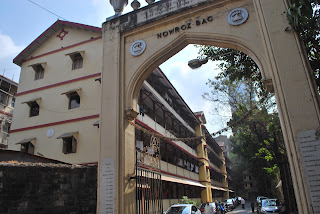Saturday Morning Stroll in Lalbaug
Lalbaug, for most Mumbaikars, is synonymous with
Lalbaughcha Raja, the magnificently tall and arguably the most iconic Ganpati
idol of the city during the annual 10-day Ganesh festival. There is an
interesting story about its origin. The fish market of Lalbaug used to be in
the courtyard of Peru Chawl across the arterial Dr Ambedkar Road. As more and
more houses came up, people started complaining about the fishy odour. Also the
market was too small to cater to the increasing demand. The fish sellers,
desperately in need of a bigger place to peddle their ware, began propitiating
Ganpati. And soon as luck would have it, Rajabai Tayyabali, a local landlord offered a plot for the construction
of a new market. The overjoyed fisherwomen, out of gratitude, installed a
Ganpati idol dressed as a fisherman and Lalbaugcha Raja was born in 1934. Interestingly Raja is a term of endearment
used by fisherwomen for the shoppers. I was privileged to be among the 20 odd
enthusiasts, who were treated to such delightful tidbits by Khaki Tours on a
sneak preview of the upcoming heritage walk through Lalbaug.
Our
walk began from the spot where Bombay Gas Company used to produce coal gas,
which was distributed throughout the island city for household cooking and
street lighting. The company ceased operation in early 1980s, when oil and gas
were struck in Bombay High. Today, the company’s 400 km long underground pipe
network is used by Telcos to run optical fibre cables for broadband
connectivity. Also close by is the humble origins of one of the most
illustrious industrialist family of the city, Godrej. Ardeshir Godrej started
manufacturing locks in 1897 from a small shed here in Lalbaug.
Lalbaug
was the epicenter of Girangaon (Mill Village), which during the heydays
comprised 130 textile mills employing nearly 300,000 workers. After a prolonged
strike, the mills started shutting down one after the other and today highrise
apartments dwarf the chimneys. The chawls that housed the mill workers also vie
for our attention with their fading but still eye-catching facades.
Curiously
the seemingly Hindu bastion of Lalbaug is named after a Muslim saint Hazrat Lal
Shah, whose tomb can be accessed after clambering over a pile of construction
materials. Believed to be the oldest Dargah (13th C?) of Mumbai, this has been
rebuilt after being destroyed in the 1992/93 riots. Not very far from this is
another Dargah, better maintained, of Chand Shah, Lal Shah’s younger brother.
Interestingly this Dargah is tended to by a Hindu family.
The
cosmopolitan character of Lalbaug is exemplified by the 2 Dargahs, a Jain
Derasar with colourfully painted pillars and brackets, a pretty temple dedicated
to Mhasoba, the buffalo-God and an Agiary overwhelmed by a 23-storey
skyscraper.
And
tucked away inside the concrete jungle is Lalbaug’s best kept secret – a 2 acre
vegetable farm – which has to be seen to be believed. The owners were jittery about
posting photographs of the green oasis and I will leave it at that.
Also
noteworthy is the New Hanuman theatre, which was a Tamasha Theatre during the
halcyon days of textile mills, and now an incongruously named marriage hall. Close
by is the shrine of Mari Aai, which according to legend is dedicated to a
Tamasha artiste.
Of
course, a tour of Lalbaug will be incomplete without the sights and smells of
Chivda Galli and Masala Galli, which is where our delightful stroll terminated
after three fun-filled hours. The walk repeats on Valentine’s Day and is highly
recommended for all those who care about Mumbai. And as Bharat of Khaki Tours,
never tires of saying, heritage walks are not just about art and architecture.

























Comments
Post a Comment